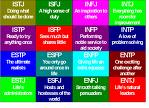Myers Briggs for Human Resource Management


Human Resource Management is one of the key knowledge areas that project managers need to be efficient in. When you are leading and managing people on projects and you want to make the most effective use of people involved with the project, an understanding of the Myers Briggs Personality Type Indicator (MBTI) tool is essential.
The purpose of this article is to educate and equip project managers with a thorough understanding and appreciation of the Myers Briggs personality type indicators. It will explain how people process information in very different ways. They also interpret life in different ways and are motivated by different things. By recognising the differences in people, the project manager is empowered to be a more effective leader who in turn will have a more motivated team.
What is Myers Briggs Type Indicator?
The Myers Briggs [personality or psychological] Type Indicators are based on the theories of Carl Jung, which he developed to attempt to explain the differences between normal healthy people. Based on observations, Jung came to the view that differences in behaviour are the result of innate tendencies of people to use their minds in different ways.
The Myers-Briggs Type Indicator (MBTI) assessment is a psychometric questionnaire designed to measure psychological preferences in how people perceive the world and make decisions. Source: Wikipedia. The MBTI instrument is called “the best-known and most trusted personality assessment tool available today. The publisher, CPP (formerly Consulting Psychologists Press) calls the MBTI tool “the world’s most widely used personality assessment”.
More blind to this than we realise
I have a friend who I connected with instantly from the moment we met. We thought the same way about many things and we shared similar strong points that we used in our very different careers. Co-incidentally, when we both did the Myers-Briggs Personality Type Indicator questionnaire, we discovered that we shared exactly the same personality type. This explained why we got along so well and why our friendship flourished.
At the same time, while managing many different projects, I came across team members who were typically classified (by colleagues) as difficult people. Upon taking a closer look, I discovered why! It was due to a very specific Myers-Briggs personality type. Being aware of the person’s personality type had made me much more effective in dealing with them in such a way as to gain their full trust and commitment to the project.
If I was blind to the existence of Myers-Briggs personality types, I would probably not know how to get past the perception of dealing with a difficult team member in order to achieve the results that I as the project manager wanted and needed.
Not to miss the rest of the article: How to Use Myers Briggs Personality Type Indicator as a project manager tool – where I explain the different components of the personality types and how that will help you achieve leadership success (next blog post), please subscribe to the RSS feed.
Also subscribe to my blog to receive more project management articles and tips in your inbox.
If you are based in South Africa, and you would like to have your team assessed with the MBTI instrument, please contact Willem Conradie & Associates – Assessment, Learning and Development Consultants, for a professional service at willem@willemconradie.co.za.




Wow this is a great resource.. I’m enjoying it.. Thanks for the good article.
Genial post and very insightful. Thanks for the great information.